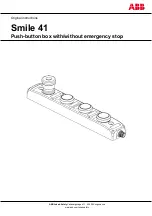
Manual MRG3
SEG Electronics GmbH
DOK-TD-MRG3, Rev. D
29
In case of an undetected mains failure, i.e. with the mains coupling C.B. closed, the vector surge
relay re-acts upon the first load change causing a vector surge and disconnects the mains C.B.
Another possibility to detect high resistance mains failures is to apply a zero current relay with an
adjustable trip delay can be used. A trip delay is needed to allow regulating actions where the cur-
rent may reach "zero" at the utility connection point. At high resistance mains failures, the mains
coupling C.B. is tripped by the zero current relay after expiry of the time delay.
To prevent asynchronous switching on, an automatic reclosing of the public grid should be blocked
for at least this time delay.
A further measure could be that the load regulation at the utility connection point always guaran-
tees a minimum power flow of 15 - 20% of the rated power.
b) Short circuit type loading of the alternators at distant mains failures
At any distant mains failure, the remaining consumers cause sudden short circuit type loading of
the power station generators. The vector surge relay detects the mains failure in about 60 ms and
switches off the mains coupling C.B. Thus, the total switch off time is about 100 - 150 ms. If the in-
dividual generators are provided with an extremely fast short circuit protection with e.g. di/dt detec-
tion function, the alternators might be switched off unselectively by the generator C.B. This, how-
ever, is not desirable because the power supply for internal requirements is endangered and a
subsequent synchronized changeover to the mains can only be done after manual reset of the over
current protection.
To avoid such a situation, the alternator C.B.s must have a delayed short circuit protection whose
time delay is at least long enough to allow mains decoupling by the vector surge relay.
4.5.4 Voltage threshold value for frequency, df/dt and vector surge
measuring
At low measuring voltages, e.g. during generator start-up, frequency and vector surge or df/dt-
measuring is perhaps not desired.
By means of the adjustable voltage threshold value UB<, functions f
1
- f
3
, df/dt or
are blocked if
the measured voltage falls below the set value.
4.6 Over current- and short circuit supervision
The phase current supervision element of the MRG3 generally protects generators; consumers or
operational supplements from over current and short-circuit. The relay provides a two-step over
current and short-circuit supervision function.
The over current function either works with an independent IDMT protection or with a DMT protec-
tion, tripping delay. For the IDMT
– protection, it is possible to optionally activate a function for the
detection of intermittent errors. If the fault detection is interrupted during the excitation phase, the
expired excitation time will be retained for a period of 60 seconds. If the fault is newly detected
within this period, the excitation time continues running. This is to prevent that faults that al-ways
recur within these 60 seconds, but whose lifetime is lower than the adjusted excitation time are
switched off safely.
The short-circuit protection is a one-step protection with un-delayed tripping or adjustable delay
time.













































